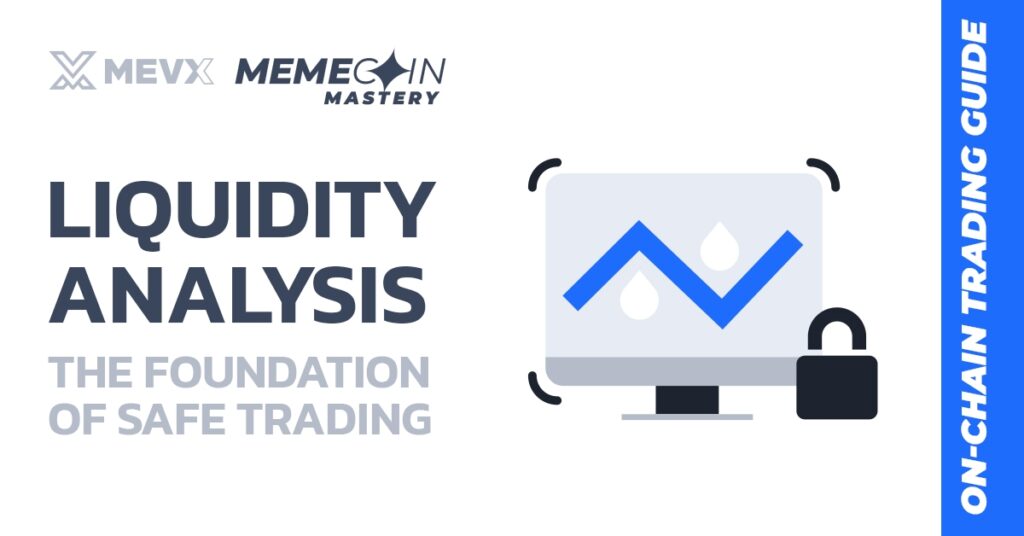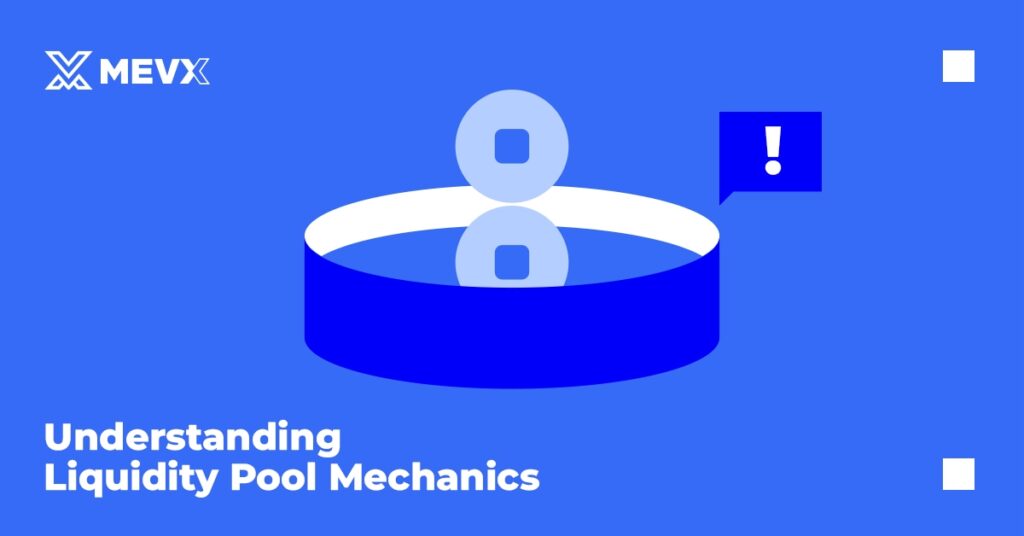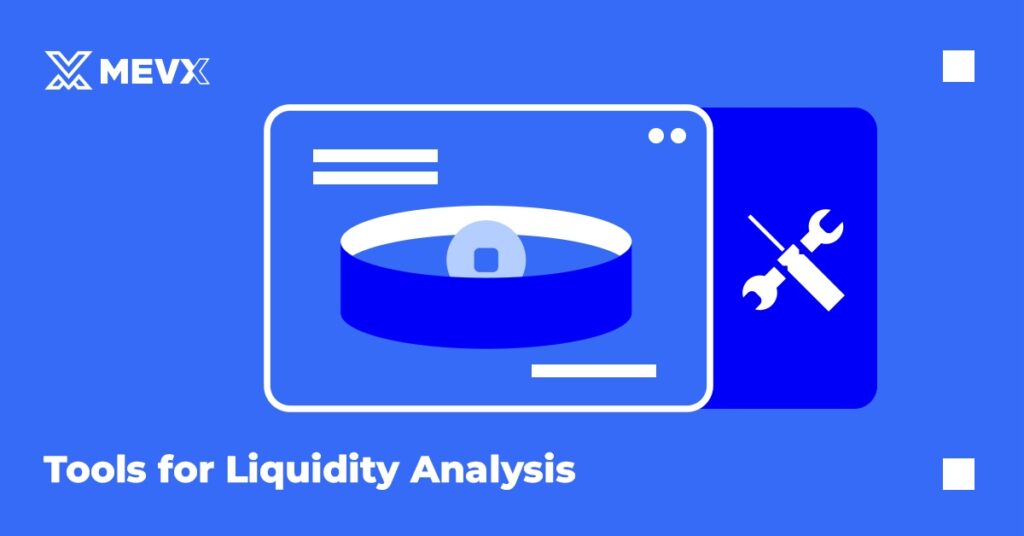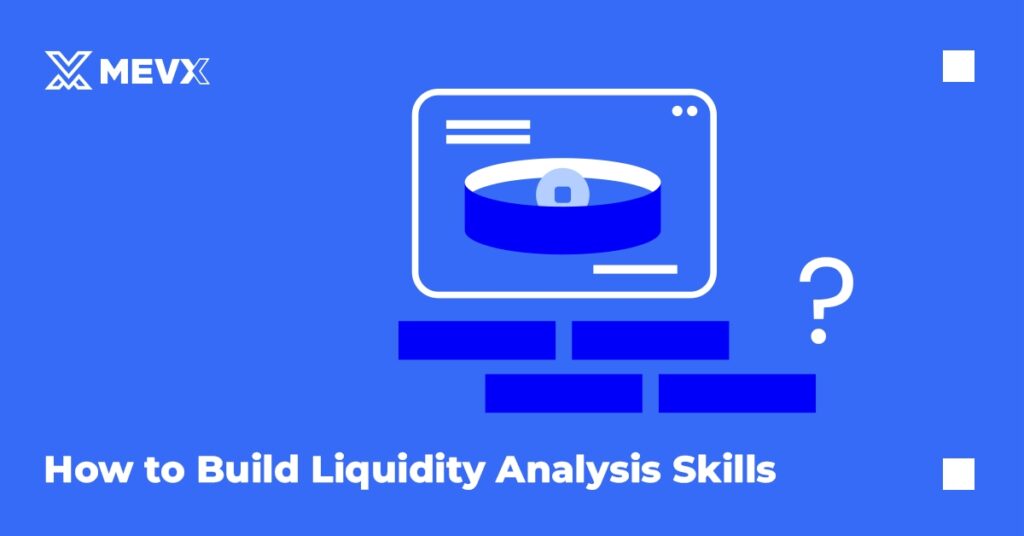In meme coin trading, profits are made or lost within seconds. But behind every fast move, there’s one silent force that determines your success: liquidity analysis.

While blue-chip cryptocurrencies have deep, stable markets, meme coins often launch with tiny liquidity pools that can vanish without warning. Understanding liquidity analysis helps you spot solid projects, avoid rug pulls, and execute trades with confidence.
How Liquidity Pools Work on Solana
Solana’s DEXs use automated market maker (AMM) models, where token prices depend on the ratio of assets in a liquidity pool.
Each pool holds two tokens, often a meme coin paired with SOL or USDC. This structure affects everything from price volatility to your ability to enter and exit trades.

Breaking Down a Liquidity Pool
When analyzing a liquidity pool, pay attention to:
Token Pair Type
Every liquidity pool consists of two assets in a specific ratio. For meme coins, this typically involves pairing with SOL, USDC, or other established tokens.
- SOL pairs: Most common, easier access for Solana-native traders.
- USDC pairs: Indicate more serious, stable project intentions.
- Exotic or custom pairs: Often red flags for manipulation or experiments.
Pool Depth
Pool depth determines how much trading volume the market can handle without significant price movement. A $100K pool handles trades better than a $5K pool.
- Check total USD value, price impact per trade, and slippage risk.
Liquidity Distribution
Analyze how liquidity is distributed across different price levels:
- Is it concentrated around the current price, or spread thin?
- Are providers adjusting liquidity dynamically as price changes?
Liquidity Locking – Commitment or Illusion?
Many meme coin projects lock liquidity after launch. But not all locks are equal.
Types of Locks
- Short-term (1–7 days): High rug pull risk.
- Medium-term (1–6 months): Standard for serious projects.
- Long-term or Burned (6+ months / forever): Strongest signal of commitment.
- Permanent locks: Liquidity burned to inaccessible address, highest security
How to Verify a Liquidity Lock
- On-chain verification: Direct blockchain confirmation of lock contracts
- Lock service platforms: Third-party platforms that manage liquidity locks
- Community verification: Independent confirmation from trusted sources
- Time-based monitoring: Ongoing tracking of lock status and expiration
For on-chain verification, visit MevX trading platform for real-time data.
Partial vs. Full Locks
Understand what percentage of liquidity is actually locked:
- Full liquidity locks: 100% of initial liquidity is locked
- Partial locks: Only a portion of liquidity is secured
- Graduated releases: Liquidity unlocks in scheduled increments
- Emergency clauses: Conditions under which locks can be broken
Spotting Dangerous Liquidity Patterns
Recognizing bad liquidity setups can save you from getting trapped.
Common Red Flags
- Extremely low initial liquidity (e.g., under $3K total)
- Single-sided liquidity: Only the meme coin, no stable pair
- Whale dominance: One wallet controls 70%+ of the pool
- Price manipulation via fake volume or sudden liquidity shifts
Tools to Perform Real-Time Liquidity Analysis
Effective liquidity analysis requires specialized tools that provide real-time insights into pool dynamics and historical patterns.

DEX Analytics Platforms
Major DEXs provide built-in analytics, but third-party platforms often offer more comprehensive analysis.
- Raydium Analytics: Native analytics for Raydium pools with detailed metrics
- Jupiter Analytics: Aggregated data across multiple Solana DEXs
- DexScreener: Multi-chain liquidity tracking with advanced filtering
- Birdeye: Comprehensive token analytics including liquidity analysis
Real-time Monitoring Tools
Set up monitoring systems for continuous liquidity tracking.
- Pool depth alerts: Notifications when liquidity falls below thresholds
- Large transaction monitoring: Tracking significant liquidity movements
- Price impact calculators: Real-time assessment of trading costs
- Arbitrage opportunities: Cross-pool price difference identification
It’s easy to cover all by following MevX signal channels on Telegram and choosing MevX for on-chain trading because it supports multi-chain trading.
Historical Analysis Platforms
Understanding liquidity trends over time provides valuable context.
- Liquidity growth patterns: How pools develop over time
- Seasonal variations: Time-based liquidity patterns
- Market correlation: How liquidity responds to broader market conditions
- Success indicators: Liquidity patterns of successful vs. failed projects
Trading Strategy Based on Liquidity
Even with a promising token, you need a liquidity-informed trading strategy.
Position Sizing Based on Liquidity
Your position size should be proportional to available liquidity.
- Conservative approach: Never trade more than 1-2% of total liquidity
- Moderate approach: Up to 5% of liquidity for experienced traders
- Aggressive approach: Higher percentages only for exceptional opportunities
- Exit planning: Ensure you can exit your position without excessive slippage
Slippage Tolerance Settings
Configure appropriate slippage tolerances based on liquidity conditions:
- High liquidity pools: 0.5-1% slippage tolerance
- Medium liquidity pools: 1-3% slippage tolerance
- Low liquidity pools: 3-5% slippage tolerance
- Emergency exits: Higher tolerance for risk management trades
Have a quick look at the following example to understand
Position Sizing For $100K liquidity pool:
- Conservative: max $1K
- Moderate: up to $5K
- Aggressive: only if you accept high slippage
Slippage Settings:
- High liquidity: 0.5% – 1%
- Low liquidity: 3% – 5%
- Use price impact calculators before executing trades
Exit Planning:
- Always know how to exit your position
- Set alerts for liquidity drain or major LP withdrawals
Building Liquidity Analysis Skills
Developing expertise in liquidity analysis requires practice and continuous learning as markets evolve.

Practice Frameworks
- Historical case studies: Analyze past liquidity events and outcomes
- Simulation exercises: Practice analysis on various liquidity scenarios
- Real-time tracking: Monitor liquidity changes in real markets
- Performance correlation: Track how liquidity analysis affects trading results
Continuous Improvement
- Tool mastery: Become proficient with multiple analysis platforms
- Pattern recognition: Develop intuition for liquidity patterns
- Market adaptation: Adjust analysis methods as markets evolve
- Community learning: Share insights and learn from other traders
Is the Liquidity Sustainable?
A pool with $50K today might have $0 tomorrow. Ask: What keeps LPs around?
- Trading fees
- Farming rewards
- Market-making bots
- Belief in the project’s long-term value
If LPs are only there for rewards, they’ll disappear when incentives dry up. Strong projects have fee models or token designs that encourage lasting liquidity.
Quick Checklist – Your Liquidity Survival Kit
Before you trade a meme coin, check:
- LP total value over $100K?
- 100% or high % of liquidity locked?
- Paired with SOL or USDC?
- Reasonable price impact for your trade size?
- Verified lock & pool data via trusted platforms?
- No signs of whale control or manipulation?
- Clear LP incentives for sustainable liquidity?
Conclusion: Trade the Liquidity, Not the Hype
In meme coin trading, hype fades, but liquidity speaks the truth.
Mastering liquidity analysis gives you a huge edge. It helps you enter early, exit clean, and avoid rugs that catch others off-guard. As with all things in DeFi, staying alert and data-informed is your best protection.
In the next article, we’ll explore token distribution, how to detect insider holdings, identify whales, and spot healthy vs. risky holder patterns.
Share on Social Media:
